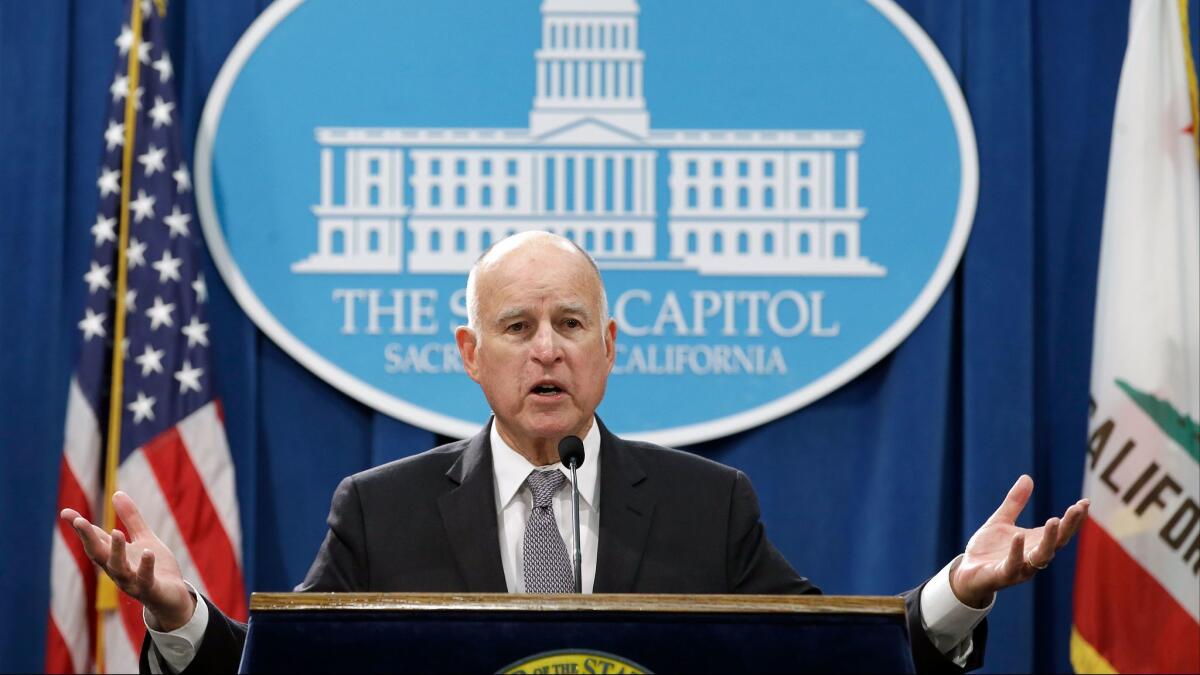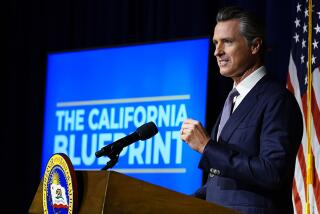Capitol Journal: In his final state budget, Gov. Jerry Brown is tying up loose ends for his successor — and protecting his rear

- Share via
Reporting from Sacramento — It seemed like Gov. Jerry Brown was tying up loose ends and starting to pack as he unveiled his 16th and final state budget proposal Wednesday.
He’ll be walking out the door and into retirement — at least from state office — at the end of this year.
Brown was 36 when first elected governor in 1974 and he’ll be 80 when he leaves for the last time. His four terms are the most of any California governor.
The youthful hair is long gone, but not the tight grip on the state pocketbook, the passionate oratory or showmanship.
Brown’s goal with the final budget he sent the Legislature is to leave state government in sound financial shape for his successor. He isn’t embarking on any major new projects. Instead, he’s polishing up existing projects, in some cases endeavoring to assure they’re sustainable.
Protecting his rear as he leaves the governor’s office has been Brown’s obsession in recent years. He learned from the first time he was governor.
“I don’t want to get caught in the jaws of the persistent fiscal instability of the state of California,” Brown once told reporters. “One thing we know is when governors leave town with big deficits, they’re more scorned than praised.”
Democrat Brown heard the scorn in 1983 when he left his successor, Republican Gov. George Deukmejian, with a badly bleeding budget. And his father, Democratic Gov. Pat Brown, heard it even louder in 1967 when he dumped a barrel of red ink on his successor, Republican Gov. Ronald Reagan.
But Jerry Brown has generally been a penny pincher for most of his career. And he’ll be missed by moderate Democrats and, especially, fiscally conservative Republicans. It’s a good bet that no Democrat likely to succeed him will be nearly as tight with a buck.
Brown was in typical form at his budget news conference when a reporter noted that faculty activists at the University of California and state universities were dissatisfied with the 3% increase he was proposing for each institution. That’s not enough, they insisted.
“It is enough,” the governor shot back. “You’re getting 3% more. And that’s it. They’re not going to get any more…. I think they need a little more scrutiny over how they’re spending things…. They’ve got to lower the cost structure…. And they need to step up and more creatively engage in the process of making education reasonable and affordable.”
Brown proposed doing that with community colleges, which he targeted for a 4% increase. His first elective office was as a board member of the Los Angeles Community College District in 1969.
He wants to give community colleges $120 million to develop an online program for the estimated 2.5 million Californians ages 25 to 34 who hold a high school diploma but want more education. These are people who must work to support themselves and their children and can’t afford to take time off to attend class. But they could go to college online at home.
“These young adults lack the skills and education to succeed in the modern economy and, therefore, are particularly at risk of being laid off during a recession,” Brown said in his budget write-up.
Brown placed $46 million in the budget to pay for a bill he signed last year that will allow any first-year, full-time student to attend a community college without paying course fees.
The governor also wants to quickly turn last year’s increases in fuel taxes and vehicle fees into highway repair projects. Republicans, in an effort to draw GOP voters to the polls in November, are trying to qualify a ballot initiative to repeal the unpopular tax hike. Brown proposed spending $4.6 billion on road projects about the time Californians will be voting.
Asked about the anti-tax ballot measure, Brown said: “It hasn’t qualified yet. Secondly, there will be a very strong opposition to it.”
Coverage of California politics »
That opposition would be funded primarily by highway contractors and labor unions.
For Brown, the highlight of his $190.3-billion budget proposal — a roughly $132-billion general fund, $56 billion in special funds, $2.5 billion in bonds — is the $5 billion he wants to stash in a rainy-day fund. That’s $3.5 billion more than he’s legally required to piggy-bank. And it would bring the total savings to $13.5 billion, only to be spent when the next inevitable recession hits.
He’s like the street corner preacher shouting that the end is near — the end of good times and the return of doom.
Right now Democrats are exuberant about surplus revenue rolling into the state treasury, Brown said. But if Sacramento isn’t careful, it will become “exuberance followed by regret and pain.... We know how it works.” Ten years ago, the state was yoked with a $42-billion budget deficit and the Legislature was forced to whack vital programs.
Of course, there’s a stench of hypocrisy here too.
Brown isn’t attempting to do the tough task that’s badly needed: modernize California’s archaic tax system to make it less volatile by lowering state income and sales tax rates and extending the sales tax to services. That’s a real solution, not a temporary rainy-day Band-Aid.
He’ll also be leaving the next governor with a bullet train wreck, a $64-billion high-speed rail system that is far behind schedule and short tens of billions of dollars.
Brown should face up to that before he walks out the door.
Follow @LATimesSkelton on Twitter
ALSO
Santa can’t fix these problems with California’s state government
The Republican tax plan is a victory for the Democrats — maybe
More to Read
Get the L.A. Times Politics newsletter
Deeply reported insights into legislation, politics and policy from Sacramento, Washington and beyond. In your inbox three times per week.
You may occasionally receive promotional content from the Los Angeles Times.











